It’s pretty safe to say Crystal Palace have largely been a mixed bag in the 2022/23 Premier League season. Patrick Vieira’s stint ended in disaster as the Eagles had been flirting with relegation before the coach was sacked, and they had to start anew. And start anew they did, appointing Roy Hodgson as their new manager, who admirably steered the ship to a mid-table finish and (some) piece of mind.
But the road was long and full of bumps. In 2022/23, we saw a team who never really established themselves as true competitors for meaningful spots in the English top tier but rather one that was trying very hard to salvage what could be salvaged at that point. Hodgson did implement some semblance of a tactical identity, though. The results were far from impressive, but they were enough to avert disaster — at least for now.
Palace finished 11th in the end, scoring 37 goals from 40.88 xG and 389 shots, good enough for 0.11 xG per shot. By all accounts, a decent, if not underperforming display in front of goal. Similarly, they conceded 49 goals from 49.15 xG faced, with the goalie preventing 3.68 goals in total from the 45.68 xG he faced. By all accounts, a good return once more, in line with their mid-table finish.
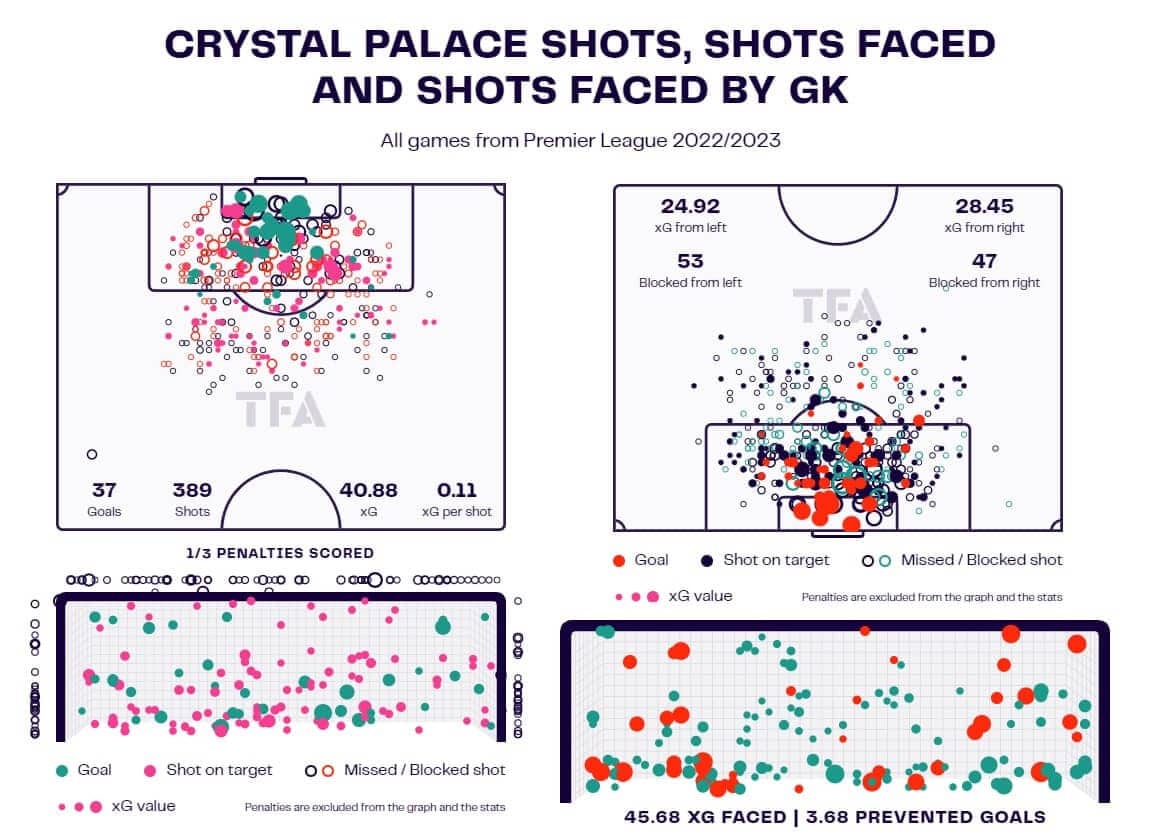
With Hodgson getting a full season with Crystal Palace in 2023/24, it will be interesting to see how he adapts and how he sets the team up for success. Of course, the first step will be to build on the foundations he’s set in the previous half-campaign, which was decent but likely could’ve been even better had it not been for that inconsistent first part under Vieira. Palace have shown they can tango with the big teams, taking numerous big scalps such as Arsenal, Manchester City or Tottenham Hotspur.
However, a big part of their potential rejuvenation lies in a great summer transfer window.
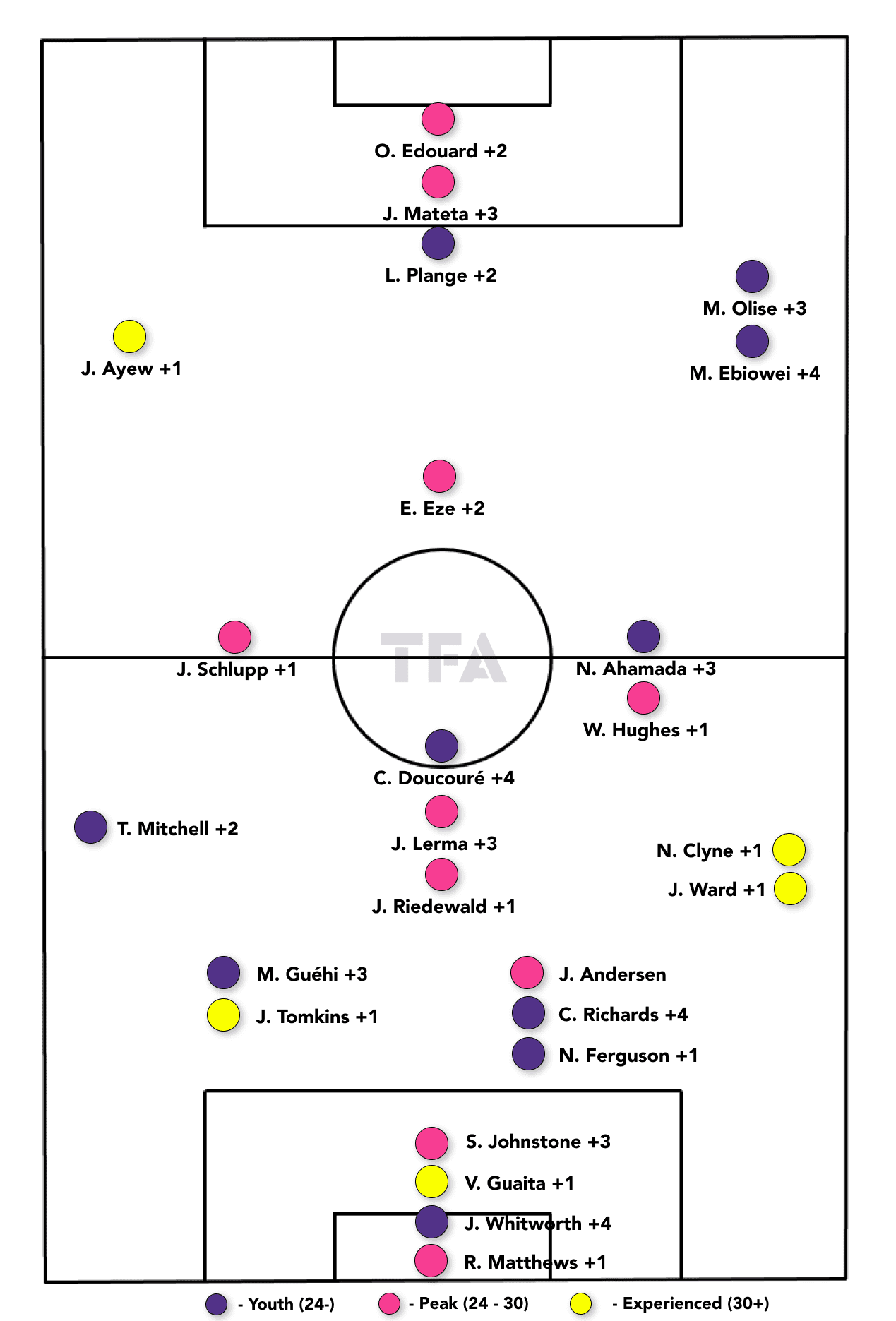
The squad as is right now is decent but far from complete. Various questions still need answering, especially concerning key figures such as Wilfried Zaha and Cheick Doucouré, both of whom might not be playing for the Eagles come the start of the 2023/24 Premier League season. The latest rumours suggest the former is closer to staying at Selhurst Park than leaving as a free agent, while the latter is flirting with Liverpool, who might have to cough up potentially £70m to land the coveted defensive midfielder.
On the other side of the coin, the only confirmed signing made by Crystal Palace at the moment of writing is Jefferson Lerma. The 28-year-old former Bournemouth player is an interesting midfield profile. Still, one has to wonder whether the club had actually transferred him as a precaution in case Doucouré truly leaves the squad.
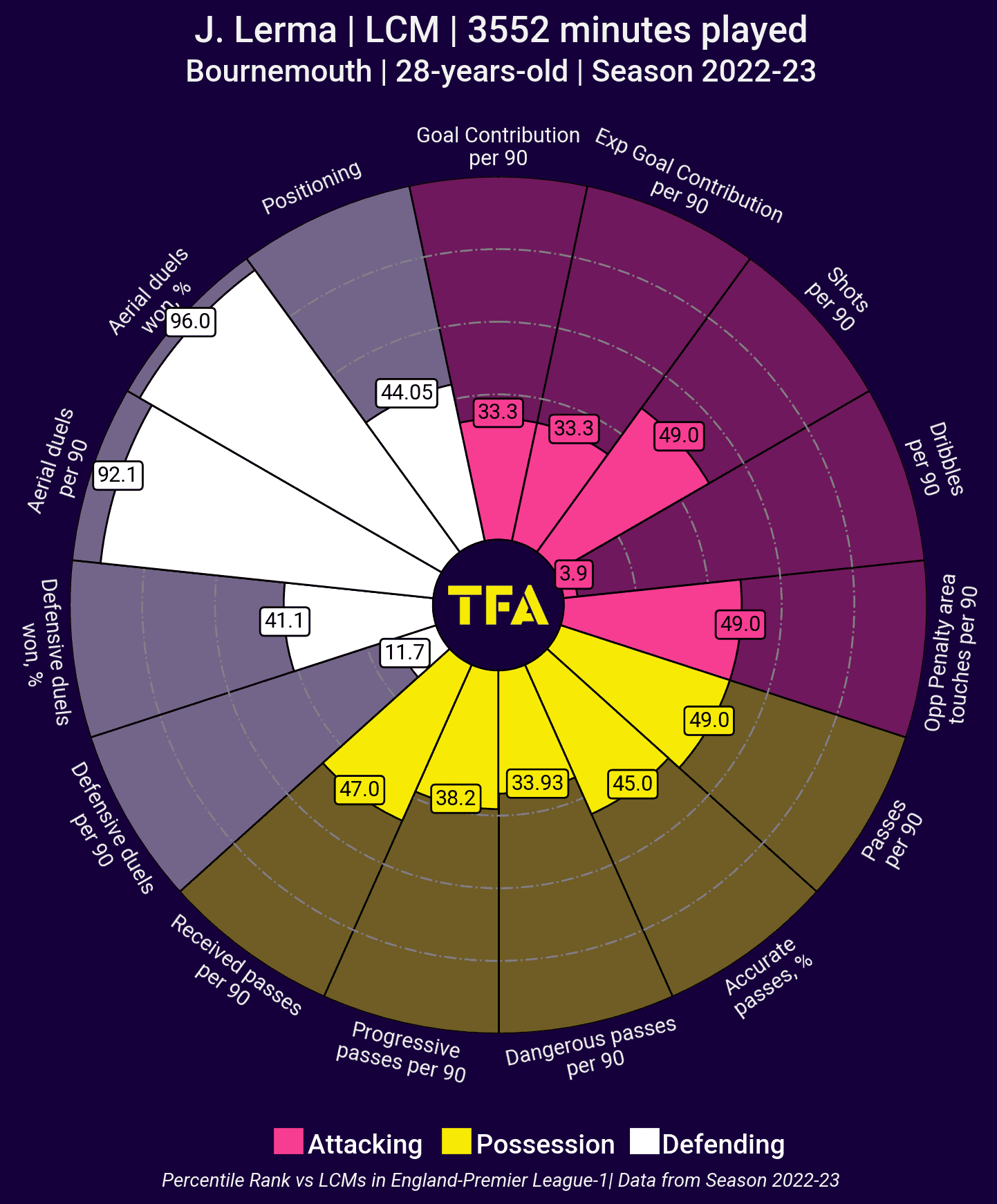
By all accounts, Lerma will help keep Palace tight, secure and resilient in defensive set pieces as well as a threat in the offensive ones. He’s a player who dominates everyone in the air and is generally a good dueller on the ground. However, compared to Doucouré’s much more versatile and complete profile, he’s hardly a like-for-like replacement in terms of pure quality. The Malian footballer is much more established on the ball despite his potential replacement boasting more received passes and a higher volume in possession.
That said, they are comparable in the way they could both operate at Crystal Palace, but a drop in quality could and should be expected if Doucouré is to leave the club. By consulting our xGOLD Team tool, we found two exciting defensive midfielder targets the Eagles could like: Raphael Guzzo from the Portuguese Vizela and Jonathan de Guzmán from Sparta Rotterdam. Both players boast an 87% match to Crystal Palace in the defensive midfielder position, with the former’s projected impact being rated as big and the latter’s as at least medium.
Attacking phase
Under Hodgson, Crystal Palace have been much improved compared to what they had been under Vieira. The new coach likes to deploy his team in a 4-2-3-1 formation, utilising the immense firepower of the quartet consisting of Eberechi Eze, Michael Olise, Zaha and either Jordan Ayew or Odsonne Édouard. Quite clearly, there is an argument to be made that Hodgson’s tactics do rely on the individual quality of his star players. Still, their utilisation has also allowed them to make immense progress in the second half of the 2022/23 season.
Palace were far more deadly in front of goal, registering more goals and expected goals, but were also keeping and circulating the ball more efficiently, increasing both volume and time in possession. As we will see further down the line of this tactical analysis, the main idea is often to get the ball out wide through a more direct approach of switching play via diagonals or progressive runs from the deep.
As a whole, however, with an average of 47.29% possession last season, the Eagles are still not ones to practise extremely possession-heavy tactics and a lot of times, Hodgson’s team was very rapid and very vertical.
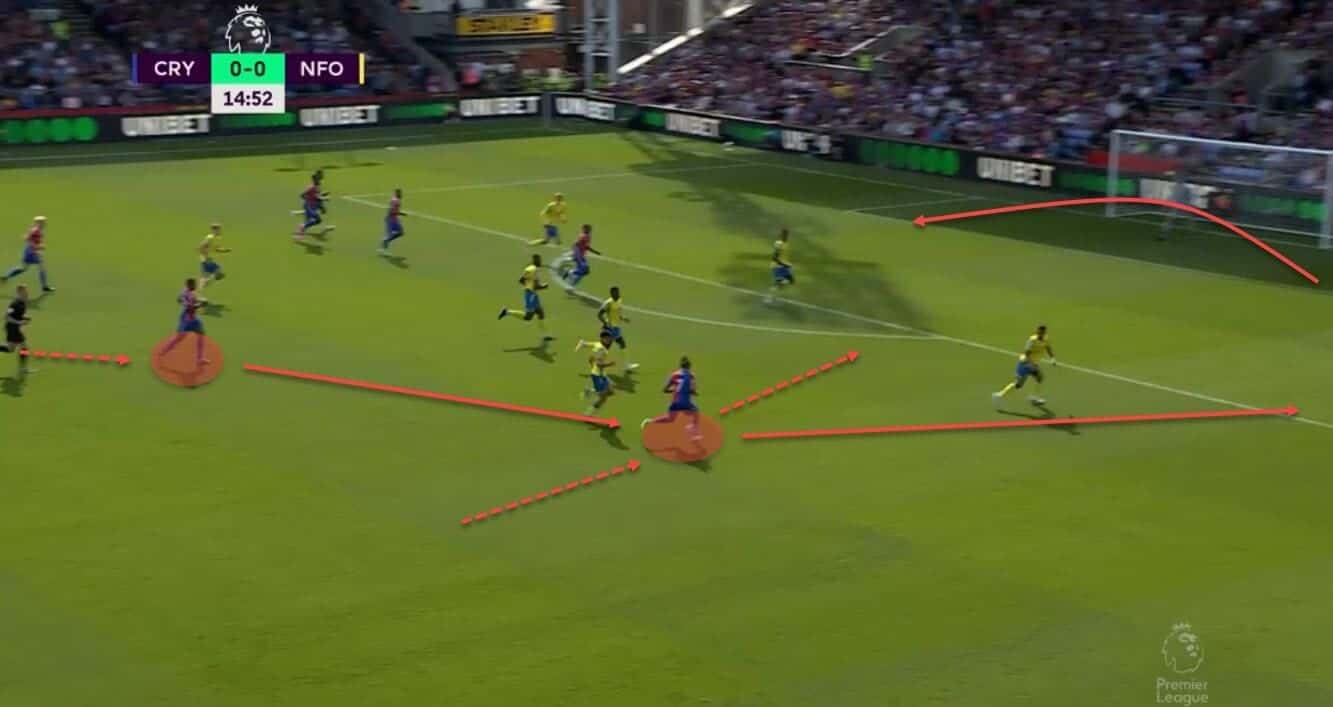
The centre-backs did have some time on the ball but would generally recycle until a runner or an outlet appeared somewhere higher on the pitch. The wingers would occasionally drop to support the build-up and offer lay-off options, and the pivot(s) would be the first receivers as well, but the Eagles rarely shied away from quick vertical releases. A similar thing can be seen in the latest example.
This move ends up in a cross into the box, but it was only preceded by three other moves before it: 1. The defenders linking up with the defensive midfielder, 2. The defensive midfielder receiving from the deep, turning with the ball and finding the inverted winger, and 3. The winger running with the ball forward and laying it off to the full-back attacking space behind the opposition’s defensive line.
This vertical nature is the direct result of the attacking profiles at Hodgson’s disposal, as the team in the forward line is full of good outlets and attackers of space. At times, the tactics impose themselves on such occasions.
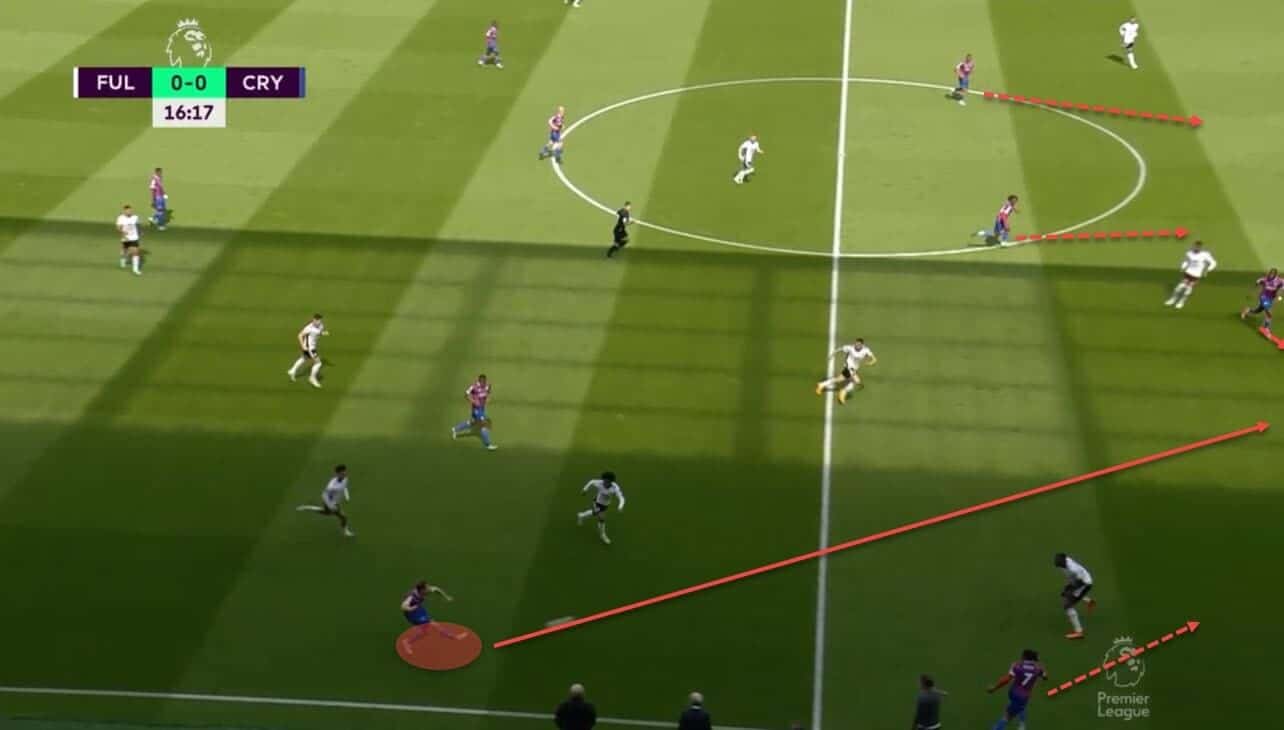
Having the distributors deep and ensuring there’s always an outlet in case the build-up is clogged up is an excellent way to break the opposition’s press effectively. Palace would often do just that, aiming for the runners attacking space and then relying on their raw speed and unpredictable nature to finish off the job. Naturally, this wasn’t always as successful, nor was it the only way for them to attack, but it did play to some of their star forwards’ core strengths.
In such situations, playing a high line against Crystal Palace, who have Zaha, Ayew, Olise and Eze all running at you, is not a position anyone would like to be in. That being said, there were situations in which Palace found ways to be more positional as well. Hodgson liked to push both his midfielders and full-backs slightly higher, giving more support to his main attacking pieces, ensuring they didn’t end up isolated on their own flanks, something Vieira needed to address appropriately.
This would create triangles between the midfielder, winger and full-back, giving more scope to outplay the opposition and release the forwards into space.
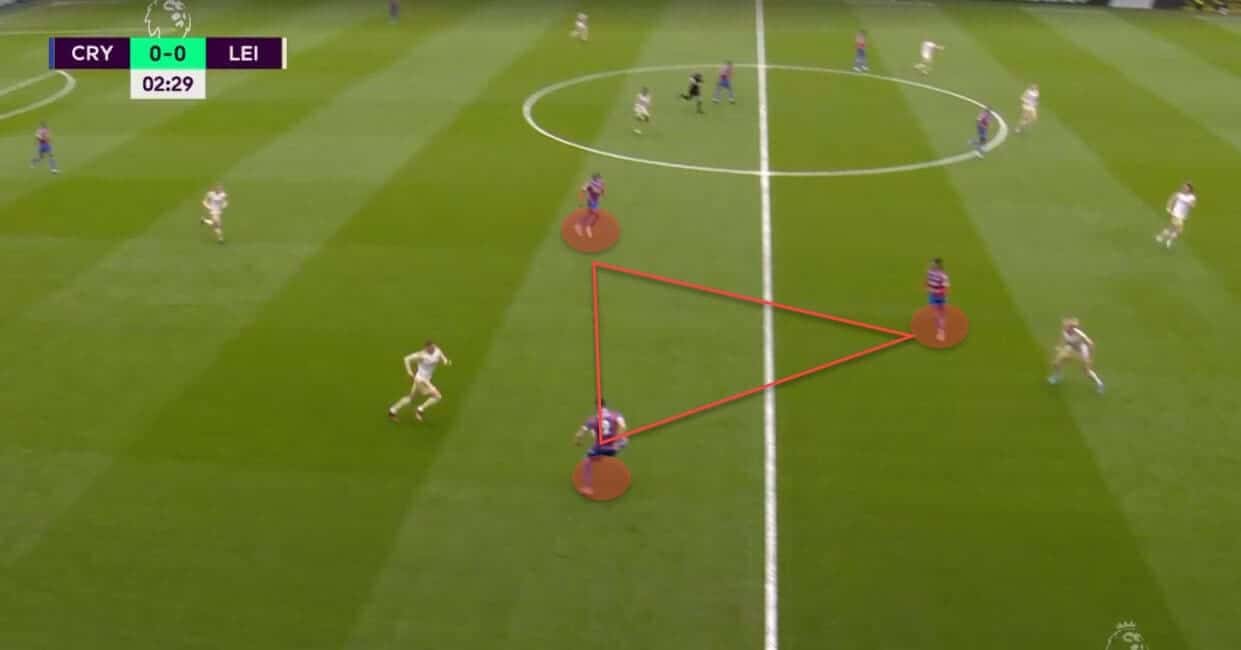
Overall, while they were always open to going down the direct route, Hodgson created a suitable environment for them to have a well-connected structure still. This ultimately laid the foundation for the success that would ensure a disaster was promptly avoided.
Defensive phase
Even though Hodgson’s tenure started off with a much more aggressive approach off the ball, Palace’s PPDA of 12.74 is still above the league average of 9.59, indicating they let the opposition have the ball for longer than most Premier League teams usually do. That being said, we saw both the high-pressing and the more conservative systems in place in the second half of the 2022/23 season.
In a high press, Palace would often resort to a man-marking approach, leaving only the far-sided wide defender free in such scenarios. It does seem like a big emphasis was put on tracking and marking the opposition’s defensive midfielder(s), as that seemed like the only real constant in Palace’s pressing variations.
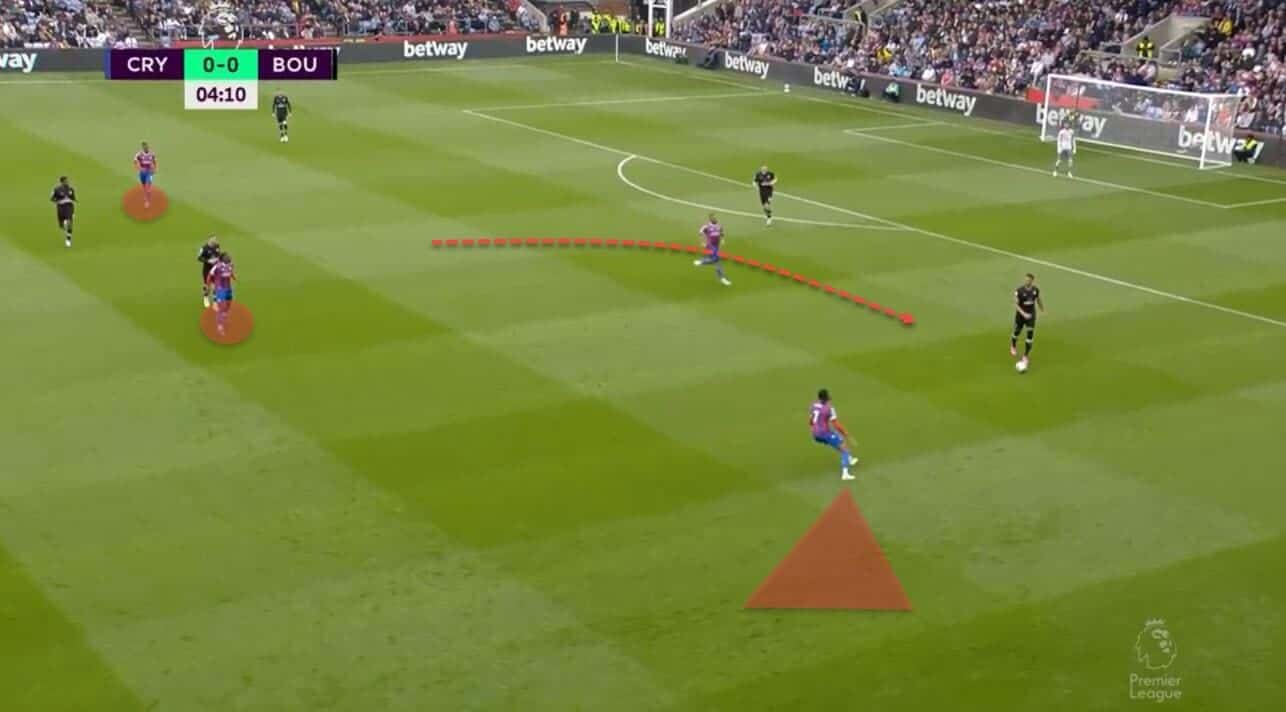
While this has led to some success in high recoveries, especially when tallying interceptions, Palace still ended the season as a team with average to decent duelling prowess. The issues were largely with a lack of compactness and synchronisation when pressing high up, as the team wasn’t moving as a unit at all times in such situations. This, alongside Hodgson’s managerial preferences, prompted the Eagles to revert to a much deeper defensive line, prioritising their solidity in a low-to-mid block most of the time.
We would often see Palace in different variations of a 4-1-4-1, 4-2-3-1 or a 4-5-1 system, the latter of which optimises both the congestion of the central areas with midfielders clogging those channels and their transition power, which we’ll touch upon in the next section of our tactical analysis. The following image gives us a glimpse of this defensive setup in action.
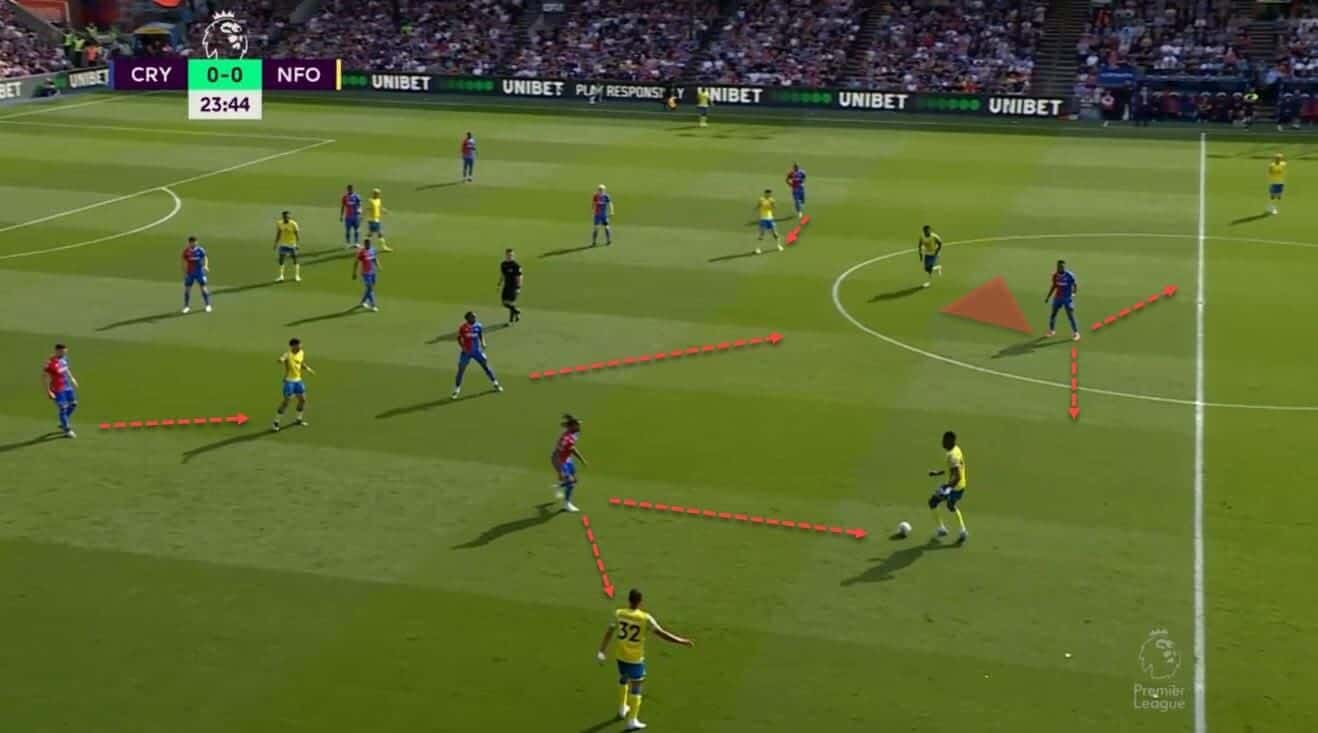
Essentially, Palace would deploy a sweeper (or two) just ahead of the defensive line to solidify their between-the-lines presence and would then push their midfielders to press the ball carrier as and when the situation to do so arose. In the example here, we see their right side push up, and the domino effect it has on the players positioned deeper on the pitch. As one player moves away from his initial position, another takes his place, and Palace keep the middle congested while the opposition remain marked as tightly as possible.
Naturally, with their wingers high and wide, even in such setups, it allowed for an easier transition into counterattacks and attacking space. This is the perfect segue into the next section of our scout report.
Transition phase
We’ve talked about Crystal Palace’s transitional power already, but we’ll touch on it slightly more in this part of the tactical analysis. Outlets, runners and overall attackers of space are all a big part of Hodgson’s tactics; his team, on average, plays more long balls per 90 minutes, has less possession and is generally more direct in their approach than some of the more positional teams in the league. This goes hand in hand with the profiles of their players, which gel well with the transition-heavy approach.
The sheer pace and unpredictability of the forward line means once Palace go full throttle and get access to the space in behind, there is very little the opposition can do to stop it. When you pair that up with distributors from the deep, it becomes a deadly combination.
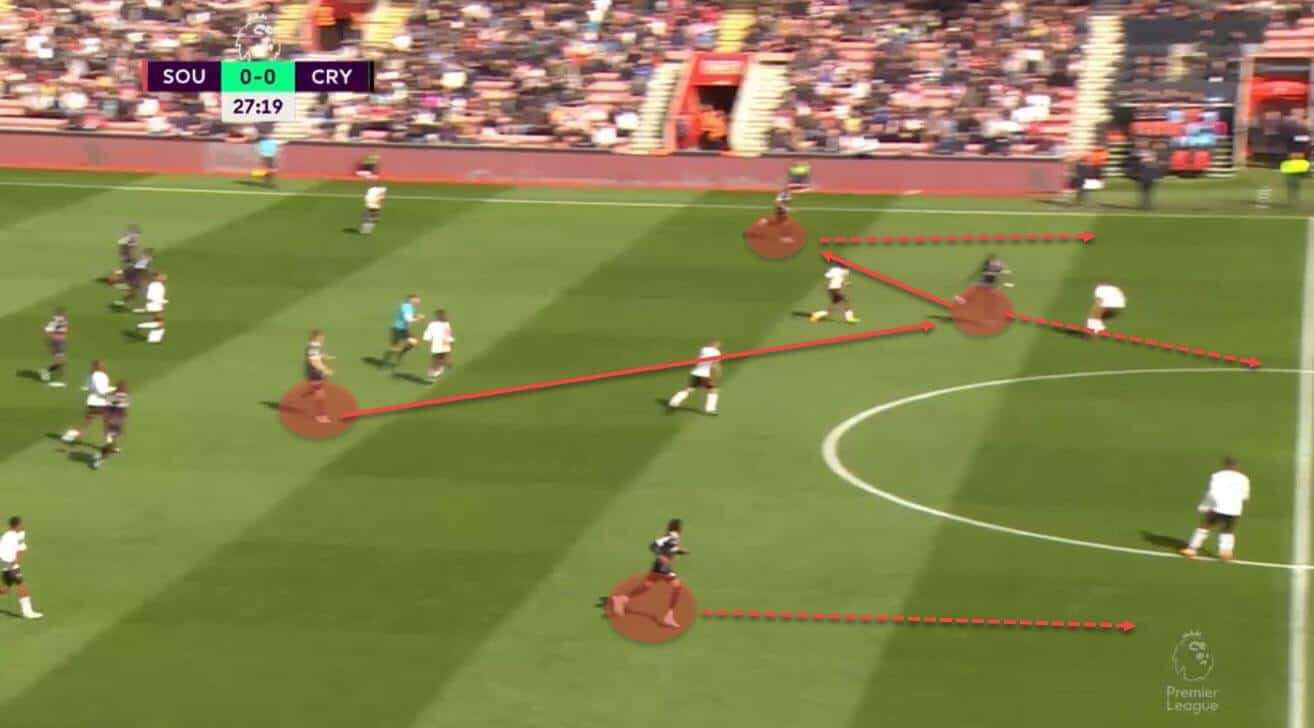
It helps to have a striker who can lay the ball off to the runners from deep on either side of him, as seen in the example provided here. Either way, the speed at which their forward line can move up the pitch is frightening and remains one of Palace’s primary weapons in possession. However, this overly attacking nature, with Hodgson instructing both the full-backs and the midfielders to join the attack often, can leave them lacking compactness in the middle third of the pitch, especially if and when they lose the ball up high.
The rest defence in many such situations consists of two defensive midfielders having to cover large spaces, which, realistically, they cannot do alone. The silver lining here is that they have hard-working players who are willing to track back even in the face of a desperate situation.
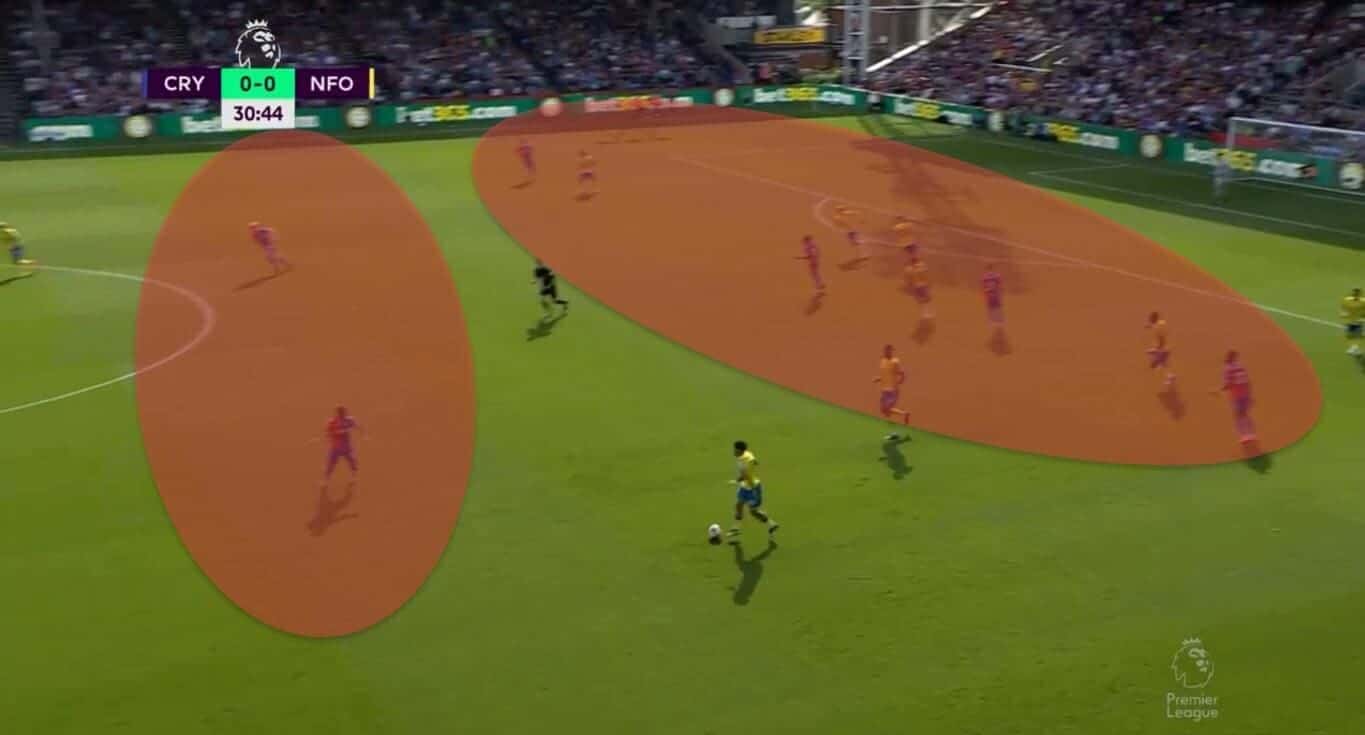
Either way, it seems that Palace often live and die by their high-speed, high-verticality approach. It remains to be seen whether that remains true in 2023/24. Before wrapping the analysis up, there’s one more thing we need to discuss.
Should Crystal Palace continue being so expansive?
One of the big questions heading into next season is whether Hodgson should stay faithful to some of the tactical principles he instilled at Selhurst Park in the half-campaign he was given in 2022/23. One such principle was exploiting the wide areas a lot. It makes sense on paper as that’s generally where you can find some of Palace’s most dangerous players; players like Zaha, Olise or even Eze.
Looking at their progression and winger actions from last season, we can see that focus in action.

A large number of runs and dribbles for Crystal Palace start in the wide areas of the pitch, and this is where their threat is mostly coming from. Again, having the difference-makers often occupy those same spots is precisely why we saw that shift happen. Given that Hodgson was tasked with using any means necessary to steady a sinking ship, the decision to play to the team’s strengths makes the most sense.
Palace were most intense in the deep left half-space in their own half and then out wide to the right when inverting and crashing into the opposition’s box. This is interesting as the switch from left to right was not uncommon last season, and we would see their attacks both originate and finish in the wide areas. Similarly, the right side is still the more dominant one when it comes to pure attacking output, as we will see in the latter parts of this analysis too.
Moving further up the pitch, we will consult the data once more, this time dissecting their shot assists and penetrating carries into the opposition’s penalty area.
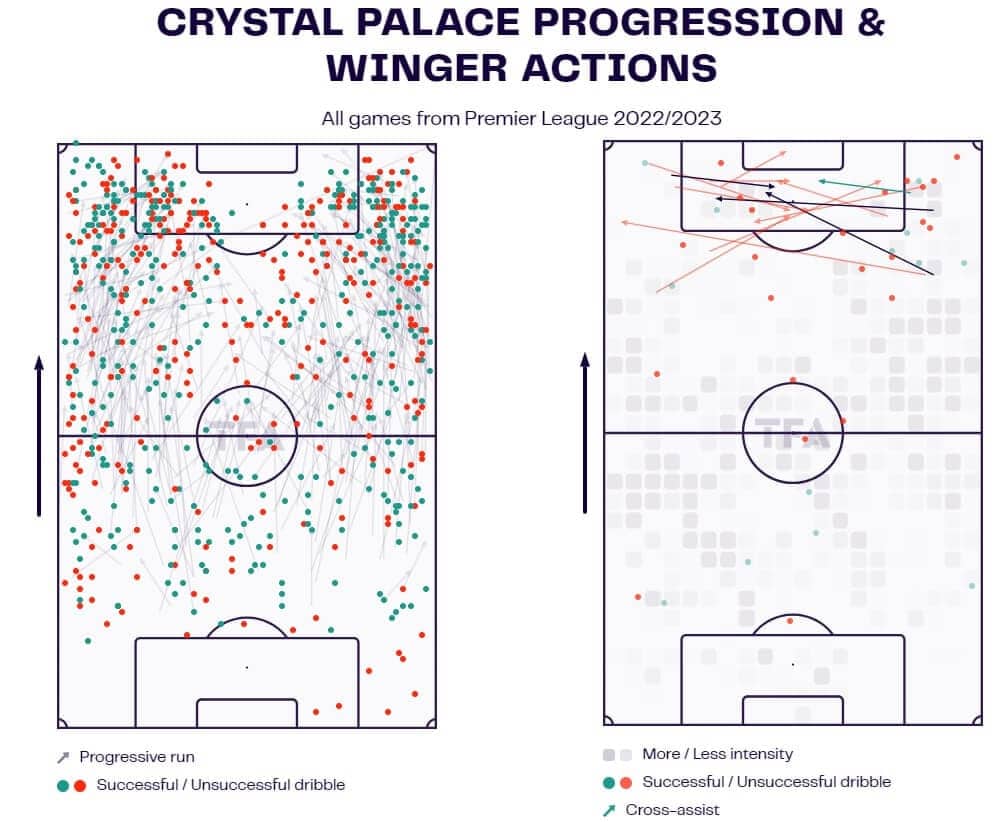
Interestingly, the image on the left confirms the left-to-right switch, and we can see both the deadlier nature of their right side and the focus on entering the box via the wide areas in both examples shown. Palace’s main threat originates from the flanks, which are generally the channels they will use to get into meaningful attacking positions. All of this points to a valid tactical principle that transformed the Eagles into a highly expansive side on the ball.
They have generated 25 assists from 25.83 xA and completed 285 penetrating carries in 2022/23, both of which, combined with their 37 goals from 40.88 xG, brought them from the brink of relegation to a comfortable mid-table finish. Clearly, the tactics worked as imagined, and Hodgson lived to fight another day. However, upon closer inspection, all is not what it might initially seem.
Yes, Palace were decently effective in these flank-focused setups, but they still need a real bite to their attack for this to be a viable long-term option that would yield significant progress. Let’s look at some more data.
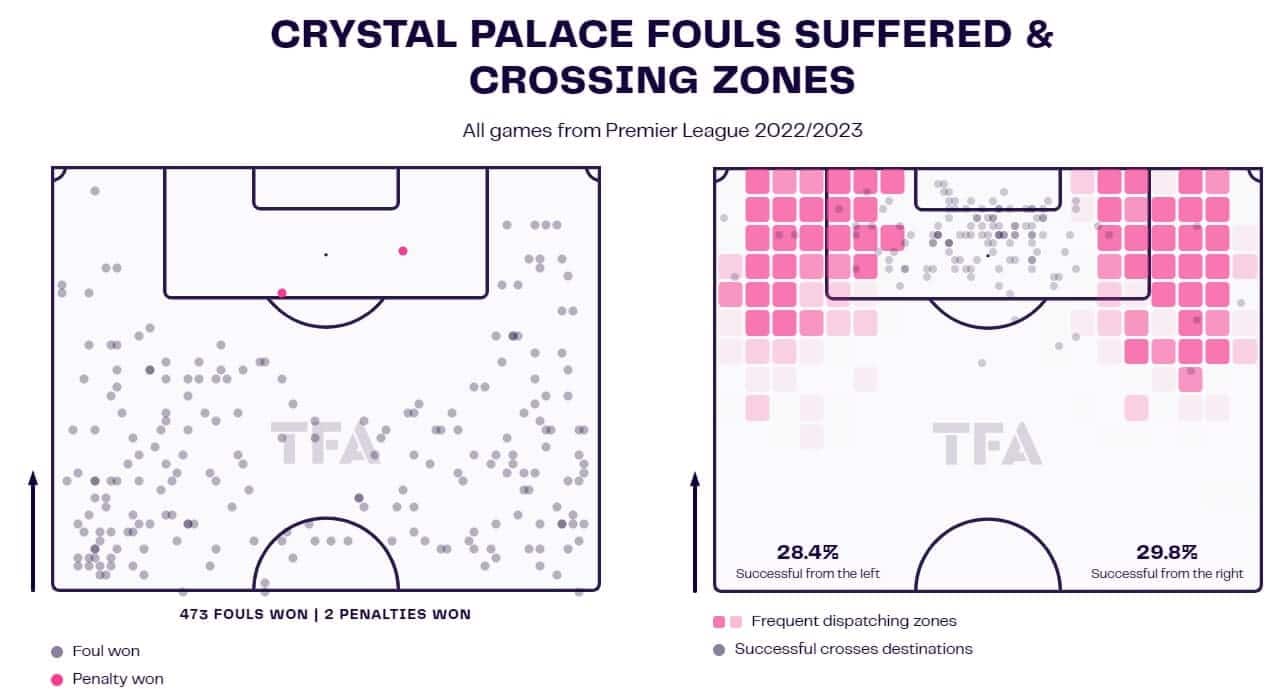
Crystal Palace don’t often top the charts when it comes to the statistical analysis, but one thing they are exceptional at are 1v1s and dribbling. According to Wyscout’s data, this is the only category in which they are comfortably in the top spot in the Premier League (first in both total figures and per 90), and again, this is due to their wingers. The likes of Olise and Zaha are incredibly tricky to mark, and with such creative power on the flanks, it’s also easy to see why the focus is often there. The graphs we see here confirm this but also pose an interesting question: can or should this be more optimised for 2023/24?
With such high-quality wingers, Palace get a lot of fouls in the wide areas and can set themselves up for deliveries or set-piece plays higher up the pitch. In the 2022/23 Premier League season, the Eagles racked up a total of 473 fouls, including two penalties. But then we come to their crossing quality and proficiency. According to our data, Crystal Palace are among the worst crossers in the Premier League, tallying only a 28.4% success rate from the left and 29.8% from the right, not even cracking the 30% mark. This score is worse than most other teams in the league, with only Everton and West Ham registering worse results.
Despite the wide areas being their undisputed strength, it is far from optimised, and Palace should be getting far more from them than they have been so far under Hodgson. Back to our initial question: should they continue being so expansive in 2023/24? The answer is not so black and white, but yes, they should. The only caveat is whether they retain their most valuable wide attackers since Zaha is, at the moment of writing, a free agent, and there have been some rumours about Olise being a potential target for some other European clubs too.
Should both stay, or in case Palace can somehow replace or even upgrade on them, the answer imposes itself quite clearly. However, the final product of those highly creative and dribbly wingers is still a big question mark.
Their utilisation is straightforward, but the output is still not there. In that sense, Palace only have the foundation set but still have a long way to go until that translates into a viable long-term plan for success.
Key player: Eberechi Eze
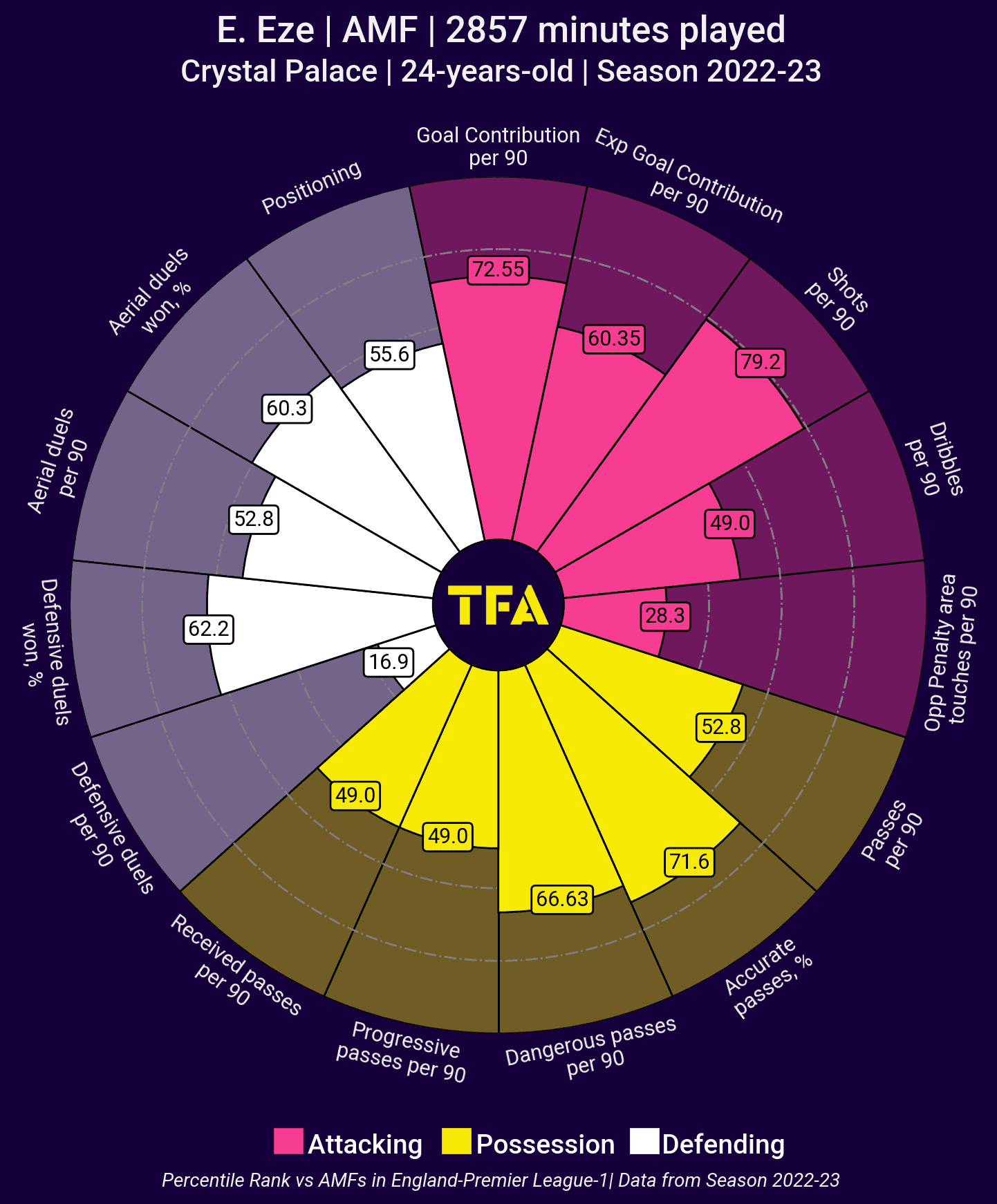
Interestingly, Eze is not the only player who deserves a shout in the category of the key player for the upcoming season. However, his incredible output in 2022/23, combined with the fact he’s bound only to get better, means he’s very difficult to omit too. Looking at the pure numbers, we can see why Eze was so crucial for Palace’s revival under Hodgson.
The 24-year-old has a very complete and versatile profile, not necessarily topping many categories but consistently dropping above-average to excellent numbers across the board. This is quite impressive for such a young player in a highly competitive league and playing for a team that’s struggled for more than half a season. Of course, the attacking output is where he truly shines.
Looking at his profile here, we can see Eze is a volume shooter and is someone who can outperform his expected goals contributions even with a below-average number of touches inside the opposition’s penalty area. The 24-year-old doesn’t need many chances to convert, nor do the tools at his disposal vastly limit him. Quite clearly, he will continue being a crucial attacking piece of Hodgson’s jigsaw going into the new season ahead of us, and the coach’s decision to reintroduce him to the squad seems like a stroke of genius now.
But best of all, he is hardworking, too, winning his duels and boasting an impressive sense of defensive positioning. Eze doesn’t engage in many challenges, but when he does, he often wins them — a trait any coach would gladly take from his leading attacking player.
One to watch: Malcolm Ebiowei
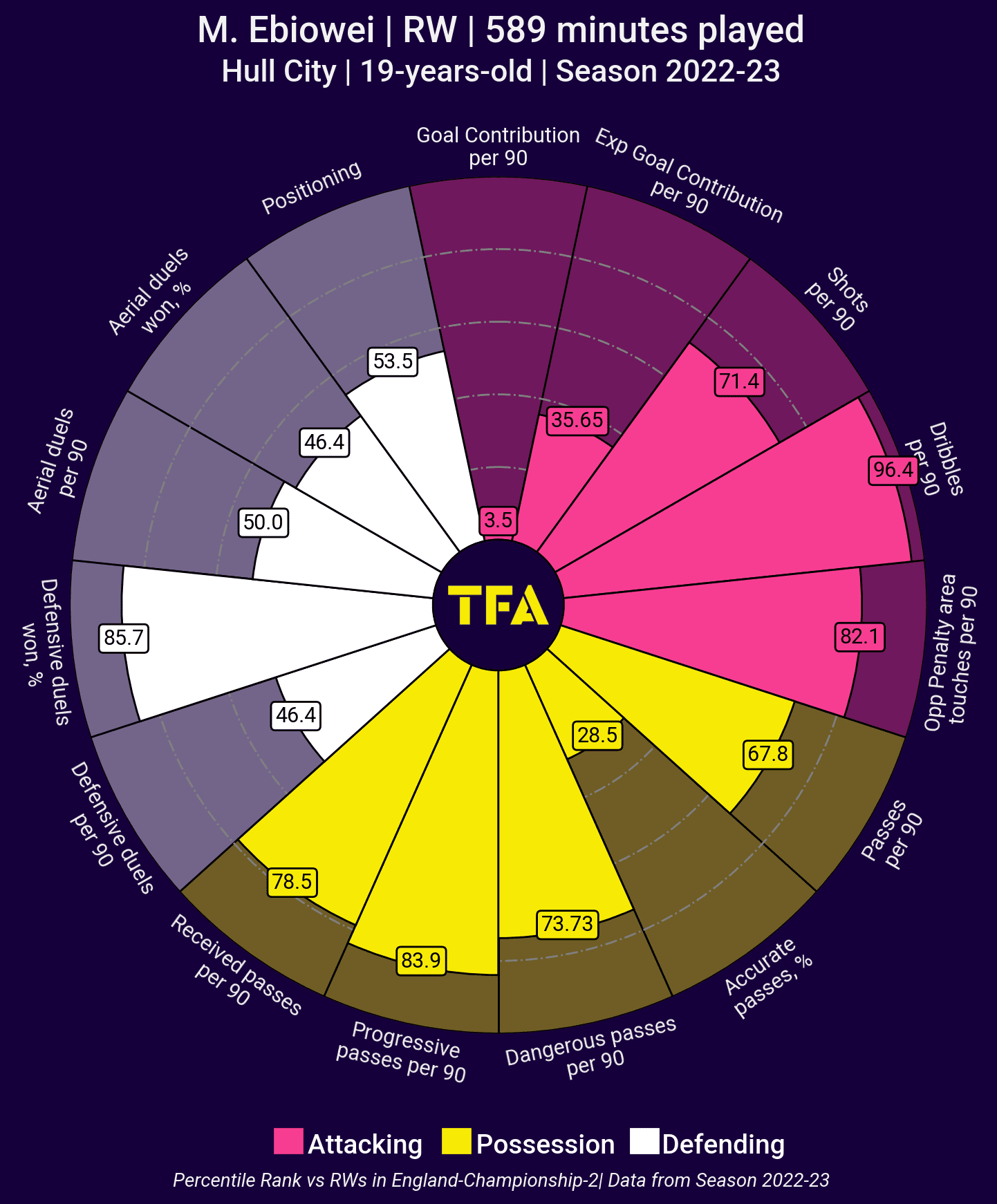
Malcolm Ebiowei is a prospect worth paying attention to at Crystal Palace. The youngster is now returning from loan at Hull City after impressing in the Championship as a tricky winger on the right side of the pitch. The 19-year-old’s future is still uncertain, and at the moment of writing, we still don’t know whether he’ll actually be given a proper chance by Hodgson or if he’s to be loaned out again.
However, considering Palace’s focus on the wide areas and the possibility of losing several big attacking players in the squad, maybe banking on their youth wouldn’t be such a bad idea. Looking at the data, Ebiowei certainly looks like someone Hodgson could take a liking to.
The young winger is pacey, tricky and likes to dribble, as seen from his quite surreal numbers in the player profile. Similarly, he is an excellent creator on the ball, which is something Palace could use from their flanks to optimise that delivery quality and perhaps add to the foundations Hodgson had set in 2022/23. One thing, however, that could be a potential problem is the lack of a final product.
Ebiowei is a creator, not a goal-scorer; the numbers support that thesis. While his inclusion could be beneficial in the long-term — depending on his development, of course — in his current form, the 19-year-old would not solve Palace’s wide conversion issues. As mentioned, he could help optimise the chance creation but wouldn’t do much to rattle the inside of the opposition’s net by himself.
Still, he’s someone who’s still flying under the radar, and if given a chance, he could turn into a shrewd signing for the Eagles.
TFA Verdict: 11th
Palace have some of the most exciting young talent in the Premier League being guided by the most-experienced manager on the block. Last season suggested Hodgson has adapted a little more and will let his team attack – but it still means 11th for them, if not a slightly more entertaining 11th than usual.






Comments